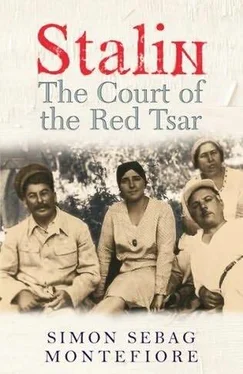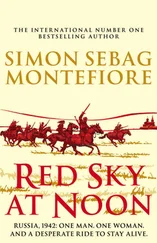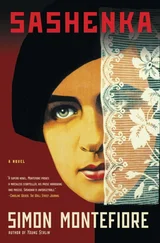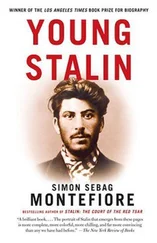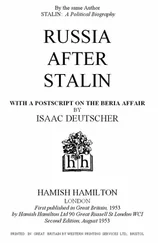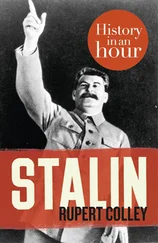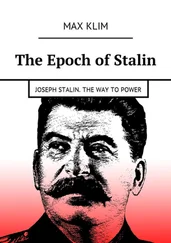Stalin and his magnates often laughed about the NKVD’s ability to get people to confess. Stalin told this joke to someone who had actually been tortured: “They arrested a boy and accused him of writing Eugene Onegin ,” Stalin joked. “The boy tried to deny it… A few days later, the NKVD interrogator bumped into the boy’s parents: ‘Congratulations!’ he said. ‘Your son wrote Eugene Onegin .’” [119] The primitive interrogators tried to suit the crime to the criminal with often absurd results: on his arrest, the First Secretary of the Jewish Autonomous Oblast in Birobizhan was appropriately accused of poisoning Kaganovich’s gefilte fish during his visit there. Presumably, throughout the many republics of the USSR, the poison was secreted in the national dishes—from the sausages of the Baltics to the spicy soups of the Buriats and the lamb stews of the Tajiks.
Many of the prisoners were beaten so hard that their eyes were literally popped out of their heads. They were routinely beaten to death, which was registered as a heart attack.
Yezhov himself devised the system of execution. Instead of using the cellars of the Lubianka or the other prisons, as his predecessors had done, he created a special abattoir. Slightly behind and to the left of Lubianka, he used another NKVD building on Varsonofyevsky Lane. The prisoners were driven in Black Crows across the road from the Lubianka (there was no tunnel) and into the courtyard where a low squarish building had been specially constructed with a concrete floor sloping towards a far wall built of logs, to absorb the bullets, and hosing facilities to wash away the fluids. After a shot to the back of the head, the victims were placed in metal boxes and driven to one of the crematoria in Moscow. The ashes were usually dumped into a mass grave such as the one at the Donskoi Cemetery. 1
The road that ended in the Donskoi often began in a note on Stalin’s desk. Stalin received not only pleas for life but denunciations demanding death. Once the Terror was unleashed, denunciations worked like kerosene on a fire, keeping it flaring up. These denunciations were already a vital part of the Stalinist system: everyone was expected to denounce everyone else. In the Bolshevik universe, there were only two ways for mistakes to come to the notice of the leaders: accidents—and denunciations. Denunciations poured into Stalin’s office: some were valid. “If we lived in a capitalist state, they’d be talking about us in the Parliament and newspapers,” said Voroshilov.
Some denunciations were the Stalinist equivalent of awkward Parliamentary questions or the work of investigative reporters: “You probably find it unpleasant that such letters are written, but I’m glad,” Stalin explained. “It would be a bad thing if no one complained. Don’t be afraid of quarrelling…This is better than friendship at the government’s expense.” But usually these poison letters were the result of witch-hunting mania, cannibalistic malice and amoral ambition.
Stalin relished the decision on how to treat the denunciations. If he did not like the person, the letters went to the NKVD with a note “Check!” and death probably followed. If he wished to “preserve” the person, he would file it and he might reactivate it years later. Hence his papers overflow with denunciations, some from ordinary people, others from top officials: a typical one, from a Comintern official, denounced Enemies in the Foreign Commissariat. 2One can only guess at the atmosphere of fear and intrigue within the Kremlin: Ordzhonikidze’s ex-secretary, surely trying to save his skin, wrote to Stalin to denounce Sergo’s widow, Zinaida, who had “said several times she can’t live without Sergo and I’m worried she’ll do something silly… She’s often telephoned by the wives of traitors to our Party. These wives turn to her with requests (to give to Comrade Yezhov). It’s not right and she must be told not to do it… I ask for your instructions. Every order will be fulfilled to the last drop of blood. Devoted to you, Semyushkin.” 3Sometimes farce turned swiftly to tragedy, like the story of how Stalin’s voice [120] At the end of 1936, when Stalin inaugurated the new Constitution, Shumiatsky, the film boss, asked Molotov if he could record Stalin’s speech. On 20 November, Molotov gave permission. Maltsev, the chief of the All-Union Committee of Radiofication and Radiosound, reported joyfully to Stalin that the speech had been successfully recorded and approved. Now he wanted permission to make it into a gramophone record “for you to hear it personally.” Stalin agreed. But on 29 April 1937, when the terrified officials of the Gramophone Trust Factory listened to the gramophone, something was wrong with Stalin’s voice. They immediately reported to Poskrebyshev that there were: “1. Big noises. 2. Big intervals. 3. The absence of whole phrases. 4. Closed grooves. And 5. Jumps and lack of clarity.” The file also contained a nervous analysis of the sibilance of Stalin’s voice and how hard it was to render on gramophone. Worse, a thousand of these records had been manufactured. Some officials wanted to recall the discs but, typically for the period, the chief attacked this suggestion for its disrespect to Comrade Stalin’s voice. He thought it more respectful to distribute them regardless of the gaps, noises, jumps. The file ends with a report from Komsomolskaya Pravda that suggested that something very sinister had happened to Comrade Stalin’s voice at the Gramophone Factory where the insistence of Comrade Straik to “distribute the discs more speedily” was a “strange position.” He was obviously a wrecker and all the guilty wreckers at the factory “must be harshly punished.” No doubt the NKVD came to listen to Comrade Straik’s record collection.
was sabotaged by wreckers. 4
A typical denunciation which Stalin read and marked came from a certain Krylov in distant Saratov, who told his leader that “Enemies have friends inside the NKVD and the Procuracy and are hiding Enemies.” 5The military were as avid as anyone else: “I ask you to dismiss Commander… Osipov,” wrote an officer from Tiflis, “who is a very suspicious person.” Stalin underlined “suspicious” with his blue pen. 6
The lightning of this Muscovite Zeus struck the regions in different ways: in July 1937, Liushkov, a ruthless Chekist who had already ravaged Rostov, was summoned to the Kremlin and ordered to the Far East. Stalin talked about the lives of men as if they were old clothes—some we keep, some we throw away: the Far Eastern First Secretary Vareikis was “not completely reliable,” having his own clique, but “it was necessary to keep” Marshal Blyukher. Liushkov obediently arrested Vareikis.
A less reliable way was to harness a local tool such as Polia Nikolaenko, the “heroic denunciatrix of Kiev,” championed by Stalin. The speciality of this terrifying crone, responsible for the deaths of as many as 8,000 people, was to stand up at meetings and shriek accusations: Khrushchev saw how she “pointed her finger and said, ‘I don’t know that man over there but I can tell by the look in his eyes that he’s an Enemy of the People.’” This talk of the “look in the eyes” was another sign of the Terror’s religious frenzy. The only way to rebut this was to answer quickly: “I don’t know this woman who’s just denounced me but I can tell from the look in her eyes, she’s a prostitute.” Now Polia Nikolaenko appealed to Stalin. Her cover note catches her simplicity: “To the anteroom of Comrade Stalin. I ask you to give this declaration personally to Comrade Stalin. Comrade Stalin talked about me at the February Plenum.”
Her letter did reach Stalin, with devastating consequences for her enemies: “Dear Leader, Comrade Stalin,” she wrote on 17 September 1937, cunningly exposing how the local bosses were ignoring Stalin’s orders. “I ask for your intervention in Kiev matters… Enemies here again gather unbeatable power… sitting in their apparat doing bad deeds. Starting from the Plenum when you spoke about Kiev and my case as a ‘little person,’ they have actively organized my discrediting to destroy me politically.” Senior officials treated her as an “Enemy” and once again used the language of witchcraft against the witch herself: “One connected to Enemies of the People cried, ‘It’s in her eyes, she’s two-faced!’” Kosior, the Ukrainian leader, and others ridiculed her “amid noisy laughter.” “I was, am and will be devoted to the Party and the Great Leader. You helped me to find Truth. STALIN’S TRUTH IS STRONG! This time I again ask you to do all you can to the Kiev organization…”
Читать дальше
